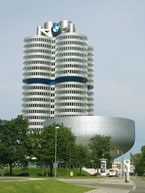2004 BMW 6-Series
Photo #3 - Enlarge photo 640x428

Photo Information (Width: 340px, Height: 227px, Size: 7Kb)
| Engine size - Displacement - Engine capacity: | 4400 cm3 |
| Transmission Gearbox - Number of speeds: | Automatic |
| Fuel Type: | Gasoline |
| Drive wheels - Traction - Drivetrain: | FR or RR |
| Price (out of date): | $48874 |
2004 BMW 6-Series specs, Engine size 4.4, Fuel type Gasoline, Drive wheels FR or RR, Transmission Gearbox Automatic
|
Used BMW 6-Series
The circular blue and white BMW logo or roundel is often alleged to portray the movement of an airplane propeller, to signify the white blades cutting through the blue sky. An interpretation that BMW adopted for convenience in 1929, which was actually twelve years after the roundel was created. In fact, the emblem evolved from the circular Rapp Motorenwerke company logo, from which the BMW company grew. The Rapp logo was combined with the blue and white colors of the flag of Bavaria to produce the BMW roundel so familiar today. The early success of the outstanding BMW IIIa inline-six aviation engine, from 1917-18 in World War I, with the Luftstreitkräfte in a limited number of Fokker D.VII fighters, as well as a number of prototype "inline-six" fighters from various manufacturers, might have actually influenced the BMW logo's design. BMW's first significant aircraft was the BMW IIIa inline-six liquid-cooled engine of 1918, much preferred for its high-altitude performance.[citation needed] With German rearmament in the 1930s, the company again began producing aircraft engines for the Luftwaffe. Among its successful WWII engine designs were the BMW 132 and BMW 801 air-cooled radial engines, and the pioneering BMW 003 axial-flow turbojet, which powered the tiny, 1944-45-era jet-powered "emergency fighter", the Heinkel He 162 Salamander, and was tested in the A-1b version of the world's first jet fighter, the Messerschmitt Me 262.[citation needed] » Read More About BMW |











